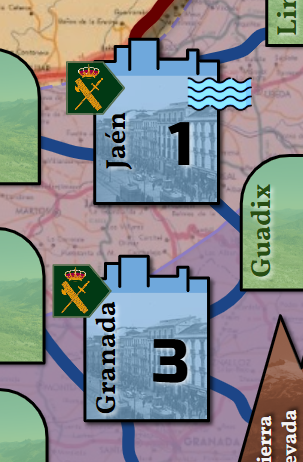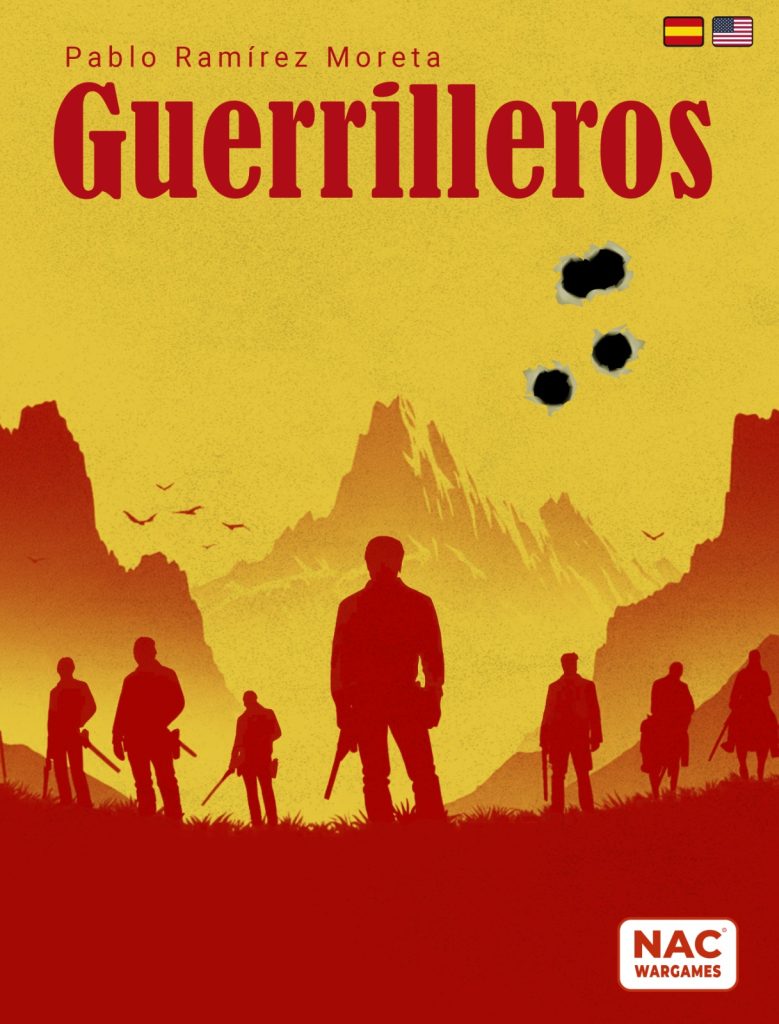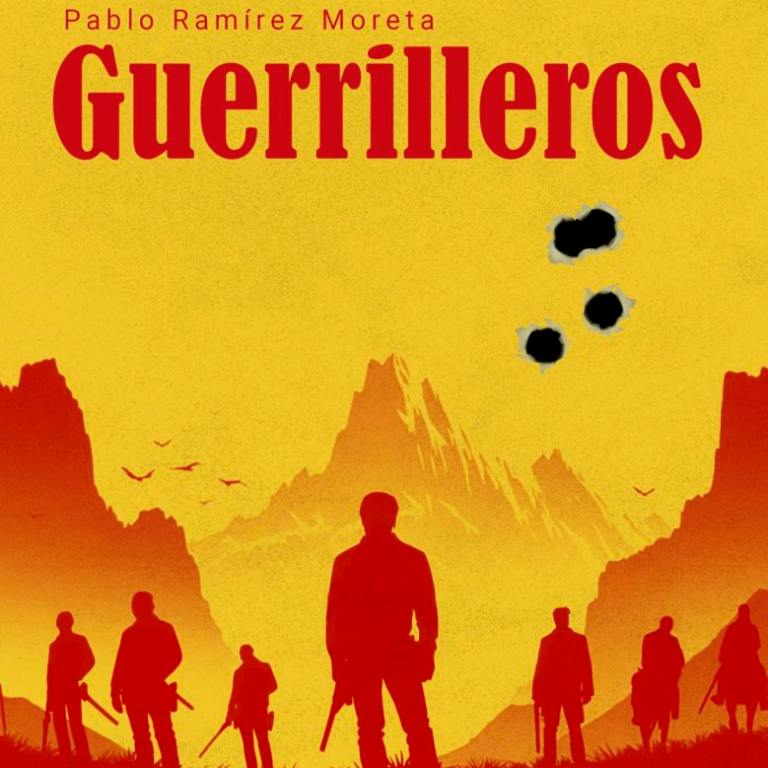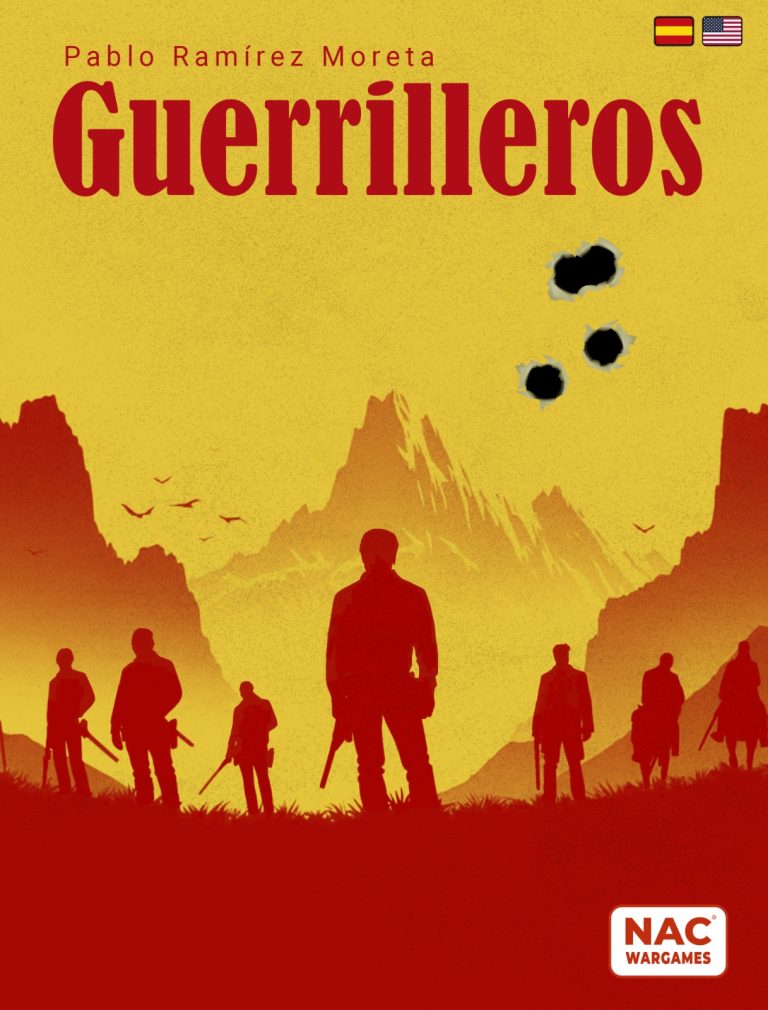
Look for the blue banner below and read this entry in English!
Si algo puedes encontrar en una partida de Guerrilleros es una buena cantidad de enfrentamientos. Más de los que el Maquis querría y menos de los que el Régimen busca. Por tanto, disponer de un buen sistema de combate que transmita los aspectos históricos de este conflicto, es clave.
Un reto complejo: ‘descender’ de la escala estratégica a una virtualmente táctica
Guerrilleros tiene una dificultad de diseño que puede pasar desapercibida: el conflicto se trata de forma nacional, a escala de país, pero las batallas son, digamos, «celulares». Es decir, la escala del juego es estratégica, pero para poder darle el sabor histórico adecuado al conflicto y sus enfrentamientos, tuve claro desde el primer momento que el combate (o sus efectos) debía ser tratado a nivel prácticamente táctico.
A priori esto puede parecer una incoherencia y, sin embargo, en el caso de Guerrilleros, es coherete y funciona muy bien.
De forma general es lógico pensar (yo lo pienso) que la escala estratégica necesita un combate acorde, donde grandes fuerzas más o menos parejas se enfrentan unas a otras y la forma de ataque, defensa y bajas, se adecue a tal escala. Pues bien, este concepto ni aplica ni funciona en Guerrilleros porque no se trata de un conflicto clásico entre dos fuerzas de magnitud similar, sino que es un conflicto tan asimétrico en fuerza y recursos como se pueda imaginar, hasta el punto en que el Maquis no tiene posibilidad alguna de éxito bélico en el largo plazo (por eso la victoria militar no es una condición de victoria del Maquis).
Tras darle vueltas a cómo unir esa brutal asimetría Régimen-Maquis con la idiosincrasia de las agrupaciones guerrilleras y del gobierno franquista, encontré una forma de reconciliar ambas escalas, estratégica y táctica, sin perder la personalización del combate, como obligaría el nivel estratégico, ni perderme en los detalles del nivel táctico.
Un sistema divertido, ágil y coherente
Pienso que un sistema de combate está obligado a mantener la inmersión de los jugadores en la batalla en curso. El resto de adjetivos del sistema (denso, fácil, largo, lleno de DRMs…) serán luego a gusto de cada uno. Sin embargo, sospecho que casi todos compartimos lo frustrante que es cuando un sistema te pone piedras en el camino (incluso aduciendo historicidad), empobreciendo la inmersión y diversión.
Por todo lo anterior, me centré en diseñar un sistema divertido, ágil y coherente al tipo de conflicto, de fácil memorización para evitar consultas a las reglas. Un sistema en el que se pudiera percibir que los protagonistas de los combates no son grandes entidades (todo un estado frente a un movimiento guerrillero residual) sino un puñado de personas frente a otras cuyos enfrentamientos y resultados tuvieran efectos a varios niveles: el narrativo, sobre las propias tropas, en el entorno civil y en el gobierno o movimiento guerrillero como entes abstractos – que están representados por los propios jugadores.
Tipos de enfrentamiento
Entremos en harina. En Guerrilleros hay dos tipos de enfrentamiento:
- CONFRONTACIÓN– se da cuando las unidades de un bando se encuentran con las del rival en un mismo área. Pueden ocurrir en cualquier área del mapa.
- INCURSIÓN – exclusivamente desencadenadas por el Maquis en áreas con Prestigio, representan los golpes de los guerrilleros en lugares estratégicos del Régimen.
Además, una confrontación de cualquier tipo puede llevar a una persecución, y que desemboca en un nuevo combate.


Procedimiento: etapas de un enfrentamiento
Todos los enfrentamientos siguen un procedimiento dividido en 4 etapas. Ocasionalmente, un compromiso concreto tendrá que ignorar una o más etapas, pero el procedimiento siempre será el mismo.
Las etapas de un combate son:
- DÍA O NOCHE – momento del combate y posibles implicaciones (el atacante tira 1d6; en las Incursiones, el Maquis deciden).
- INICIATIVA – posibles ventajas para el atacante (tira 1d6).
- COMBATE – impactos, vencedores y daños (cada bando tira varios d6, es la fase central del enfrentamiento).
- DAÑO COLATERAL – posibles consecuencias (poco frecuentes y dependientes de la tirada anterior).
- RETIRADA – posible retirada de las unidades supervivientes.
En resumen (only in Spanish):
Atacante y defensor
El atacante será el bando que origina un enfrentamiento de cualquier tipo debido a una maniobra (Mover, Desplegar). El rival, lógicamente, será el defensor.
Esto se cumple siempre excepto cuando el Maquis inicia un combate en retirada, que se considerará el defensor.
Agilidad y narrativa de los enfrentamientos
Todo ésto está muy bien pero ¿es en realidad un sistema «divertido, ágil y coherente con el conflicto«? ¿Fomenta la narratividad? ¿Es inmersivo? Tal es el objetivo y los jugadores tendrán la última palabra, pero el procedimiento así lo propone:
- La fase de Día o Noche establece CUÁNDO se da el combate, ofreciendo pros y contras aleatorios (en Confrontaciones) o voluntarios (en Incursiones).
- La fase de Iniciativa puede otorgar beneficios importantes al atacante (cobertura, vencer empates o relanzar dados) según el TIPO DE TERRENO en que se encuentre: áreas de poblaciones menores, pueblos o ciudades.
- La fase de Combate sólo necesita una tirada de tantos dados según la POTENCIA TOTAL de las fuerzas participantes (número de unidades, enlaces cercanos, armamento, fuerzas en la retaguardia o la defensa intrínseca de una ciudad con sus refuerzos); las dos tiradas permiten resolver de un golpe de vista el número de impactos, el vencedor del combate y los daños infligidos al enemigo.
- La fase de Daños Colaterales es un extra a la fase de combate que se da tras un combate con impactos no infligidos como daños al enemigo sino como posibles daños colaterales A LA POBLACIÓN CIVIL.
Estos elementos, es decir, el momento, el terreno, la potencia desplegada, los daños colaterales y la posible persecución son los ingredientes que dan la capa narrativa, inmersiva e histórica a los enfrentamientos de Guerrilleros.
Duración de un enfrentamiento
Todo lo descrito anteriormente en las diferentes fases transcurre en poco tiempo. El proceso completo implica:
- Un máximo de 2 tiradas de 1d6 – inmediatas y, en ocasiones, innecesarias.
- Una tirada de combate simultánea – se dirimen impactos, vencedor, daños y posibles consecuencias.
- Una posible consulta de daños colaterales – en función de la tirada anterior, se da en menos del 10% de los combates.
Es decir, la duración media de un enfrentamiento de cualquier tipo es de entre 1 y 2 minutos.
Estos datos son respaldados por un par de cientos de enfrentamientos celebrados en diferentes partidas, mesas y por diferentes jugadores, casi todos de nula o poca experiencia con el juego. En ese par de minutos se incluyen decisiones, recuentos, tiradas y consultas.
Por tanto, las varias decenas de enfrentamientos que se dan en una partida normal ni entorpecen la experiencia de juego ni fomentan el análisis-parálisis (AP) una vez se coge familiaridad con cada fase – lo cual suele ocurrir al segundo o tercer enfrentamiento de la primera partida de un jugador novel.
Pero… ¡ponme un ejemplo, hombre!
Calma, calma. Esta entrada me parecía muy importante para explicar, justificar y saber qué esperar del sistema de combate. Como ha quedado larga, la cierro aquí. No te pierdas las siguientes entradas si quieres ver un ejemplo de Confrontación y otro de Incursión.
– Pablo, autor de Guerrilleros
Para ayudar a que Guerrilleros sea publicado, puedes inscribirte en el programa P500 de NAC Wargames de forma gratuita y sin compromiso de compra.
Entra en la web dedicada a Guerrilleros y haz clic en el botón «Apúntame» (sólo necesitarás una cuenta de MasQueOca, ¡es fácil!). ¡Muchas gracias!

English version
If there is one thing you can find in Guerrilleros is a good amount of fighting. More than the Maquis would want and less than the Regime is looking for. Therefore, having a good combat system that transmits the historical aspects of this conflict is key.
A complex challenge: ‘descending’ from the strategic scale to a virtually tactical one
Guerrilleros has a design difficulty that may go unnoticed: the conflict is dealt on a national, country scale, but the battles are, shall we say, “cellular”. That is to say, the scale of the game is strategic, but in order to give the right historical flavor to the conflict and its battles, it was clear to me from the first moment that the combat (or its effects) should be treated at an almost tactical level.
A priori this may seem inconsistent. However, in the case of Guerrilleros, it is consistent and works out beautifully.
In general, it is logical to think (I think so) that the strategic scale needs a corresponding combat, where large forces more or less evenly match each other and the form of attack, defense and casualties, is adapted to such a scale. Well, this concept neither applies nor works in Guerrilleros. It is not a classic conflict between two forces of similar magnitude, but a conflict as asymmetric in strength and resources as can be imagined – to the point that the Maquis has no option for a military victory.
After thinking a great deal about how to blend together this brutal Regime-Maquis asymmetry with the idiosyncrasies of the guerrilla groups and the Francoist government, I found a way to reconcile the two scales, strategic and tactical, without losing the personalisation of the combat just as the strategic level would require, or getting lost in the details of the tactical level.
A fun, agile and coherent system.
I think that a combat system must be forced to keep the players immersed in the battle in progress. The rest of the adjectives for the system (dense, easy, long, full of DRMs…) will be up to each player’s taste. However, I suspect that almost all of us share how frustrating it is when a combat system gets in your way (even on the grounds of historicity), impoverishing immersion and fun.
For all of the above, I focused on designing a fun, agile and coherent system, easy to memorise to avoid frequent rule queries. A system in which it can be perceived that the protagonists of the combats are not large entities (a whole state versus a guerrilla movement) but a handful of people versus others whose clashes and results have effects on several levels: the narrative, on the troops themselves, on the civilian environment and on the government or guerrilla movement as abstract entities – which are represented by the players themselves.
Types of engagement
Let’s get down to business. In Guerrilleros there are two types of engagement:
- CONFRONTATION – occurs when units of one side meet those of the opposing side in the same area. They can occur in any area of the map.
- INCURSION – exclusively triggered by the Maquis in areas with Prestige, they represent Guerrilla strikes in strategic Regime locations.
In addition, a confrontation of any kind can lead to a chase, which will lead to a new fight.


Procedure: stages of an engagement
All engagements follow a procedure divided into 4 stages. Occasionally, a particular engagement will have to ignore one or more stages, but the procedure will always remain the same.
The stages of an engagement are:
- DAY OR NIGHT – time of combat and possible implications (attacker rolls 1d6; in Incursions, the Maquis decides).
- INITIATIVE – possible advantages for the attacker (roll 1d6).
- COMBAT – impacts, victors and damage (each side rolls several d6, this is the central phase of the engagement).
- COLLATERAL DAMAGE – possible consequences (infrequent and dependent on the previous roll).
Attacker and Defender
The attacker will be the side that originates an engagement of any kind due to a manoeuvre (Move, Deploy). The opponent, logically, will be the defender.
This is always true except when the Maquis initiates a engagement after retreating, in which they will be considered the defender side.
Agility and narrative of the engagements
This is all nice but, is it really a «fun, agile and conflict-consistent» system? Does it foster the narrative? Is it immersive? That’s the goal and the players will have the last word, but the procedure aims so:
- The Day or Night phase sets WHEN combat occurs, offering random (in Confrontations) or voluntary (in Incursions) pros and cons.
- The Initiative phase can grant important benefits to the attacker (cover, winning in ties, or re-rolling dice) depending on the TYPE OF TERRAIN of the fight: minor population areas, towns or cities.
- The Combat phase requires only one die roll of so many dice according to the TOTAL STRENGTH of the participating forces (number of units, close links, armament, forces in the rear, or the intrinsic defence of a city with its reinforcements); the two die rolls allow to resolve at a glance the number of hits, the winner of the combat, and the damage inflicted on the enemy.
- The Collateral Damage phase is an extra to the combat phase that occurs after a combat with hits not inflicted as damage to the enemy become possible collateral damage TO THE CIVILIAN POPULATION.
These elements, i.e. the moment, the terrain, the power deployed, the collateral damage and the possible chase are the ingredients that give the narrative, immersion and history layers to Guerrilleros’ combat system.
Duration of an engagement
Everything described above in the different phases takes place in a short period of time. The whole process involves:
- A maximum of 2 rolls of 1d6 – immediate and sometimes unnecessary.
- A simultaneous combat roll – hits, victor, damage and possible consequences are determined.
- A possible collateral damage consultation – depending on the previous roll, occurs in less than 10% of combats.
In other words, the average duration of an engagement of any kind is between 1 and 2 minutes.
This data is not an estimation but factual data, backed up by a couple of hundred matches held at different games, tables and by different players, almost all with little or no experience with the game. Included in those couple of minutes are decisions, counts, rolls and consultations.
Therefore, the several dozen confrontations that occur in a normal game neither hinder the game experience nor encourage analysis-paralysis (AP) once familiarity with each phase is gained – which is often the case by the second or third engagement of a novice player’s first game.
But… give me an example, man!
Easy there, I know. I thought this post was very important to explain, justify and help you know what to expect from the combat system. As it has been a long one, I will close it here. If you want to see an example of a Confrontation and an Incursion, don’t miss the following entries!
– Pablo, author of Guerrilleros
To help Guerrilleros get published, you can sign up to NAC Wargames’ P500 programme for free and with no commitment to buy.
Go to Guerrilleros dedicated website and click on the «Sign me up» button (you only need a MasQueOca account, it’s easy!) Thank you very much!




